

Natural Compounds and Plant Extracts as Therapeutics against Chronic Inflammation in Alzheimer's Disease - A Translational Perspective. Schizophrenia Is Actually Eight Distinct Genetic Disorders: New Study. Descubren una molécula capaz de frenar el Alzheimer. El gran misterio del Alzheimer es saber cómo y por qué se suicidan las neuronas "al morirse las neuronas desaparece nuestra memoria y los recuerdos", explica a la SER el investigador Carlos Buesa.

Su empresa, Oryzon, considerada una compañía pionera a nivel mundial en epigenética ha descubierto una molécula capaz de frenar el desarrollo de la enfermedad, "al menos en los ratones", apunta Carlos Buesa, "tenemos una molécula que ha funcionado en animales, pero hay que ir paso a paso, ahora tenemos que verificar su seguridad", después dará el salto a los humanos en la fase de ensayos clínicos. Hasta que eso ocurra "pueden pasar cinco o siete años", según explica el consejero delegado de Oryzon. ¿Cómo funciona ORI-2001? Esta molécula se comporta como un director de orquesta, es capaz de callar a los genes que empujan a la neurona a la muerte y activar los genes de supervivencia, "de esa forma conseguimos que la neurona se mantenga viva junto a sus vecinas, conservando nuestra memoria".
New hope for treatment of Alzheimer's disease. Judes Poirier, PhD, C.Q., from the Douglas Mental Health Institute and McGill University in Montréal (Canada) and his team have discovered that a relatively frequent genetic variant actually conveys significant protection against the common form of Alzheimer’s disease and can delay the onset of the disease by as much as 4 years.
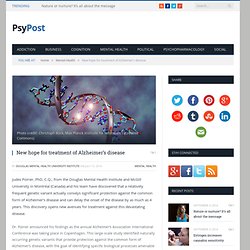
This discovery opens new avenues for treatment against this devastating disease. Dr. Poirier announced his findings as the annual Alzheimer’s Association International Conference was taking place in Copenhagen. This large-scale study identified naturally occurring genetic variants that provide protection against the common form of Alzheimer’s disease, with the goal of identifying specific biological processes amenable to pharmaceutical interventions. “These latest genetic results from Dr.
A different approach. A new diagnostic tool for dementia diseases. Vitamin D deficiency linked to increased risk of dementia and Alzheimer's disease. Vitamin D deficiency is associated with a substantially higher risk of dementia and Alzheimer's disease in older people.

According to a study completed in collaboration with Dr. News in Brief: A beacon illuminates a key Alzheimer's protein. Deep within the living brain, a newly created beacon can illuminate hidden signs of Alzheimer’s disease.
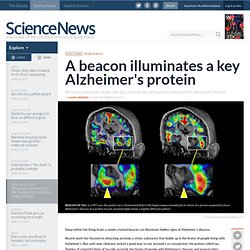
Recent work has focused on detecting amyloid, a sticky substance that builds up in the brains of people living with Alzheimer’s. But until now, clinicians lacked a good way to see amyloid’s co-conspirator, the protein called tau. Focus Shifts to Gray Matter in Search for the Cause of Multiple Sclerosis. It has taken a century so far for scientists to not figure out the cause of multiple sclerosis (MS).

The inflammatory disease, which affects more than 2.1 million people worldwide, has been blamed on toxins, viruses and even food. Most recently, scientists have placed their bets on two major ideas: The first (and far more popular) hypothesis suggests MS begins in white matter, which influences how parts of the brain work together. White matter consists of bundles of axons covered in myelin, a white insulating fatty layer. In people with MS myelin degrades and nerve fibers are left exposed, causing problems in motor coordination and loss of senses. The second hypothesis suggests that MS begins in the gray matter, which affects thinking and learning. Breakthrough offers first direct measurement of spinal cord myelin in multiple sclerosis. Researchers have made an exciting breakthrough – developing a first-of-its-kind imaging tool to examine myelin damage in multiple sclerosis (MS).
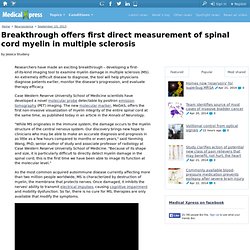
An extremely difficult disease to diagnose, the tool will help physicians diagnose patients earlier, monitor the disease's progression, and evaluate therapy efficacy. Case Western Reserve University School of Medicine scientists have developed a novel molecular probe detectable by positron emission tomography (PET) imaging. The new molecular marker, MeDAS, offers the first non-invasive visualization of myelin integrity of the entire spinal cord at the same time, as published today in an article in the Annals of Neurology. "While MS originates in the immune system, the damage occurs to the myelin structure of the central nervous system.
As the most common acquired autoimmune disease currently affecting more than two million people worldwide, MS is characterized by destruction of myelin, the membrane that protects nerves. New imaging shows Alzheimer's unfolding in live brains - health - 18 September 2013. The two major brain abnormalities that underlie Alzheimer's disease can now be viewed simultaneously in brain scans while people are still alive, providing new insight into how the disease develops and whether drugs are working.

The breakthrough comes from the development of a harmless tracer chemical that is injected into the bloodstream and accumulates exclusively in "tau tangles" – one type of abnormality that occurs in the brains of people with Alzheimer's and other kinds of dementia. Fluorescent light emitted from the chemical is picked up using positron emission tomography (PET), showing exactly where the tangles are.
The tracer remains in the brain for a few hours before being broken down and expelled from the body. Similar tracers already exist for beta amyloid plaques, the other major anatomical feature of Alzheimer's, so the one for tau tangles completes the picture. DNA damage may cause amyotrophic lateral sclerosis. Amyotrophic lateral sclerosis (ALS)—also known as Lou Gehrig's disease—is a neurodegenerative disease that destroys the neurons that control muscle movement.
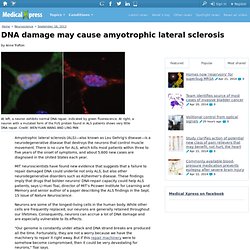
There is no cure for ALS, which kills most patients within three to five years of the onset of symptoms, and about 5,600 new cases are diagnosed in the United States each year. Fatal cellular malfunction identified in Huntington's disease. Researchers believe they have learned how mutations in the gene that causes Huntington's disease kill brain cells, a finding that could open new opportunities for treating the fatal disorder.
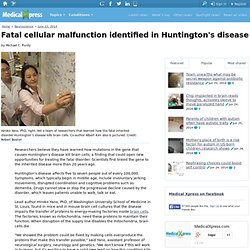
Scientists first linked the gene to the inherited disease more than 20 years ago. Huntington's disease affects five to seven people out of every 100,000. Symptoms, which typically begin in middle age, include involuntary jerking movements, disrupted coordination and cognitive problems such as dementia. Drugs cannot slow or stop the progressive decline caused by the disorder, which leaves patients unable to walk, talk or eat. Lead author Hiroko Yano, PhD, of Washington University School of Medicine in St. "We showed the problem could be fixed by making cells overproduce the proteins that make this transfer possible," said Yano, assistant professor of neurological surgery, neurology and genetics.
The findings are available online in Nature Neuroscience.